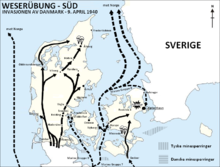German invasion of Denmark (1940)
| German invasion of Denmark | |||||||||
|---|---|---|---|---|---|---|---|---|---|
| Part of Operation Weserübung | |||||||||
 Map of Denmark showing German plans |
|||||||||
|
|||||||||
| Belligerents | |||||||||
|
|
|
||||||||
| Commanders and leaders | |||||||||
|
|
|
||||||||
| Strength | |||||||||
|
14,500 soldiers in the |
Höheres Kommando XXXI: 527 aircraft of the X. Fliegerkorps |
||||||||
| Casualties and losses | |||||||||
|
26 killed 14 aircraft damaged |
20 killed and wounded 2 captured 12 armoured cars destroyed or damaged 4 tanks damaged 1 aircraft damaged 1 tugboat sunk |
||||||||
14,500 soldiers in the
Zealand and Jutland Divisions and the Bornholm garrison
Höheres Kommando XXXI:
170th Infantry Division
198th Infantry Division
11th Schützen Brigade
26 killed
23 wounded
(includes casualties of the civil resistance)
The German invasion of Denmark was the fighting that followed the German army crossing the Danish border on 9 April 1940 by land, sea and air.
Lasting approximately six hours, the German ground campaign against Denmark was one of the shortest military operations of the Second World War.
The attack on Denmark was planned as a part of the German Operation Weserübung Süd – the German plan for an invasion of Norway. The purpose was mainly to secure the iron ore shipping from Narvik. In order to capture Norway, the Germans had to control the airfield outside Aalborg in northern Jutland. The Luftwaffe high command was in favour of occupying Denmark in order to extend the German air-defence network northwards, making it harder for British bombers to outflank the system from the north when attacking cities in Germany. Additionally, the Norwegian fjords also provided excellent bases for German submarines to attack in the North Atlantic.
The German High Command planned for a combined assault on Denmark to overrun the country as swiftly as possible, with an airborne assault on the Aalborg airfields and a surprise landing of infantry from naval auxiliaries at Copenhagen in addition to a simultaneous ground assault across the Jutland peninsula.
On 4 April, Admiral Wilhelm Canaris, the chief of the Abwehr and involved in the German resistance to Nazism, warned the Danes of an imminent invasion.
Although the Danish Army had been forewarned of the attack, it was denied permission to deploy or prepare defensive positions as the Danish government did not want to give the Germans any provocation for their actions. All that was available to meet the land invasion were small and scattered units of the frontier guard and elements of the Jutland division. Believing attack was imminent, the troops were placed on full alert at 13:30 on 8 April.
...
Wikipedia
